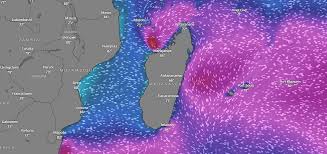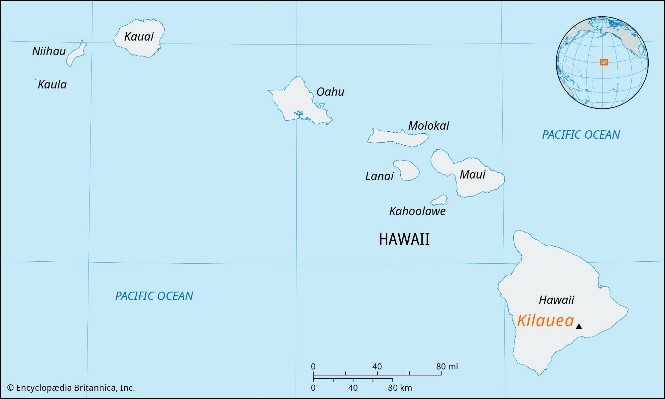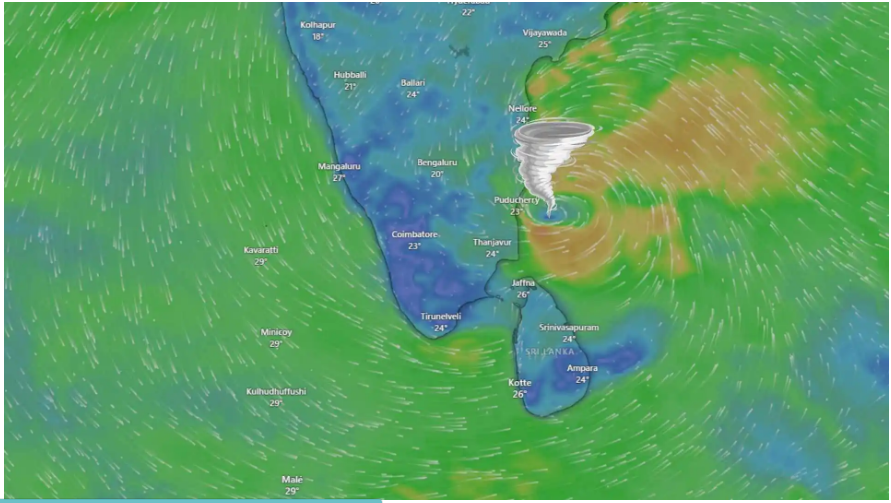Cyclone Dikeledi

- 15 Jan 2025
Cyclone Dikeledi struck Mayotte, a French overseas territory in the Indian Ocean, located in the Mozambique Channel. The cyclone caused severe flooding and damage, following closely after Cyclone Chido, which had hit the region in December 2024.
About Mayotte:
- Comprises two islands from the Comoros archipelago: Mayotte (Grande Terre) and Pamandzi (Petite Terre).
- It is the poorest region in both France and the European Union.
- Colonized by France in 1843 and annexed along with the Comoros in 1904.
- In a 1974 referendum, while 95% of Comoros opted for independence, 63% of Mayotte voted to remain French.
- While Comoros declared independence in 1975, Mayotte continues to be governed by France.
Cyclone Chido, which struck in December 2024, was recorded as the most severe storm to hit Mayotte in 90 years.
Kilauea Volcano

- 24 Dec 2024
In News:
Kilauea volcano erupts on Hawaii's Big Island.
Location:
- Kilauea is located on the southeastern shore of Hawaii’s Big Island, within Hawaii Volcanoes National Park.
Type of Volcano:
- Active Shield Volcano – Kilauea is a shield volcano, meaning it has broad, gentle slopes due to the eruption of fluid lava, which flows easily across large areas. Its eruptions tend to be less explosive than those of other types of volcanoes, creating a relatively safe environment for research and tourism compared to more volatile volcanoes.
Key Features:
- Summit Caldera: Kilauea has a large caldera at its summit, Halema'uma'u, which is a major volcanic feature. The caldera formed from the partial collapse of the volcano after the eruption of large amounts of magma. The caldera spans around 3 miles in length and 2 miles in width, covering an area of over 4 square miles.
- Rift Zones: Kilauea has two active rift zones stretching to the east and southwest, which are areas where lava can erupt and spread across the island. These rift zones are responsible for much of the volcanic activity.
- Lava Flows: Over the last 1,000 years, Kilauea has covered 90% of its surface with lava flows, making it one of the most active volcanoes in the world. It is known for producing highly fluid lava, which allows the lava to travel long distances from the eruption site.
- Historical Activity: Kilauea has had near-continuous eruptions in modern history, particularly between 1983 and 2018, with 34 eruptions since 1952. The volcano has remained active with frequent eruptions, and its lava lake was visible at the summit until 1924.
- Mythological Significance: The volcano is considered the home of Pele, the Hawaiian goddess of fire, lightning, and volcanoes. The Halema'uma'u crater is especially sacred, as it is believed to be the goddess's dwelling place.
Why is Kilauea Significant?
- Active and Young: Kilauea is one of the youngest volcanic products of the Hawaiian hotspot, a series of volcanic islands formed by the movement of the Pacific plate over a stationary plume of hot material beneath the Earth’s crust.
- Continuous Eruptions: It has been erupting regularly, with the exception of a quiet period between 1924 and 1952. Its eruptions are a significant natural phenomenon that scientists and visitors closely monitor.
- Proximity to Mauna Loa: Kilauea is located near Mauna Loa, another active shield volcano. Together, these two volcanoes form a large volcanic region, and their slopes merge seamlessly, making this area home to two of the world's most active volcanoes.
Shield Volcanoes and Kilauea
- Shield Volcanoes: A shield volcano is characterized by its broad, gentle slopes. These slopes are formed by repeated eruptions of fluid basalt lava, which spreads easily over large areas. Unlike composite volcanoes, which have steep, conical shapes, shield volcanoes like Kilauea have a much wider, dome-like appearance.
- Low Explosivity: Eruptions from shield volcanoes are generally low in explosivity, and lava flows are typically slow-moving. However, explosive events can occur if water interacts with lava, but this is relatively rare in Kilauea's eruptions.
Kilauea's Current Activity
In December 2024, Kilauea began erupting again, continuing its pattern as one of the most active volcanoes in the world. This eruption has once again drawn attention to the ongoing volcanic activity on the Big Island of Hawaii, as the volcano regularly contributes to the reshaping of the island and its landscape.
Other Volcanoes in India:
While Kilauea is known for its active status, India also has volcanic features, although most are dormant or extinct:
- Barren Island (Andaman Islands) – India’s only active volcano.
- Narcondam (Andaman Islands) – A dormant volcano.
- Baratang (Andaman Islands) – Known for mud volcanoes.
- Deccan Traps (Maharashtra) – A vast volcanic plateau formed by ancient eruptions.
- Dhinodhar Hills (Gujarat) – Extinct volcano.
- Dhosi Hill (Haryana) – An ancient volcanic site with historical significance.
Cyclone Fengal

- 27 Nov 2024
In News:
- A deep depression in the Southwest Bay of Bengal, 800 km south of Chennai and 500 km from Nagapattinam, is expected to become Cyclone Fengal within the next 24 hours.
- It is anticipated to move north-northwest towards Tamil Nadu and Puducherry.
Key Highlights:
Cyclone Fengal Naming:
- If the depression intensifies into a cyclone, it will be named Fengal, as suggested by Saudi Arabia.
- Fengal will follow Cyclone Dana, which made landfall in Odisha in October 2024.
Cyclone Naming Process:
- Panel Members: Cyclones in the North Indian Ocean are named by a panel of 13 countries under the World Meteorological Organization (WMO) and United Nations Economic and Social Commission for Asia and the Pacific (UNESCAP).
- Member countries include Bangladesh, India, Iran, Maldives, Myanmar, Oman, Pakistan, Qatar, Saudi Arabia, Sri Lanka, Thailand, the UAE, and Yemen.
- Process: Each member submits a list of 13 names, creating a rotational naming system. Names are assigned sequentially as cyclones form. Once used, a name is retired and not reused.
Cyclone Fengal’s Potential Impact:
- Fengal is expected to bring strong winds, heavy rainfall, and possible coastal flooding.
- The system’s trajectory is being closely monitored, and preparedness measures are being implemented.
Terminology of Tropical Cyclones:
Terminology Region Impact Areas
Typhoons China Sea, Pacific Ocean Japan, China, Philippines
Hurricanes Caribbean Sea, Atlantic Ocean United States, Mexico,
Caribbean nations
Tornadoes Guinea Lands (West Africa), Southern USA Southern USA, West Africa
Willy-willies Northwestern Australia Australia (especially
Northwestern region)
